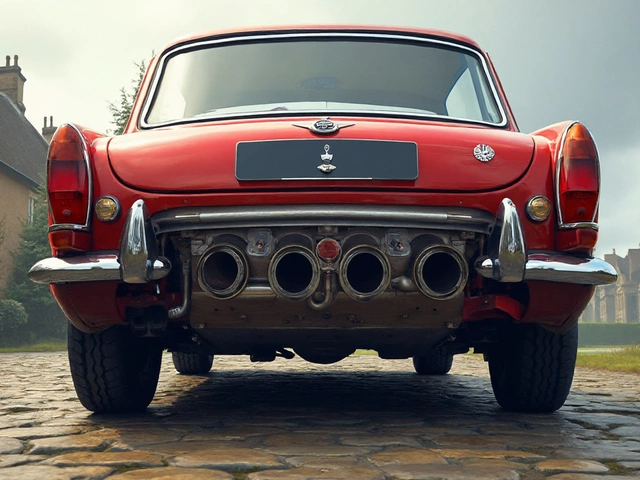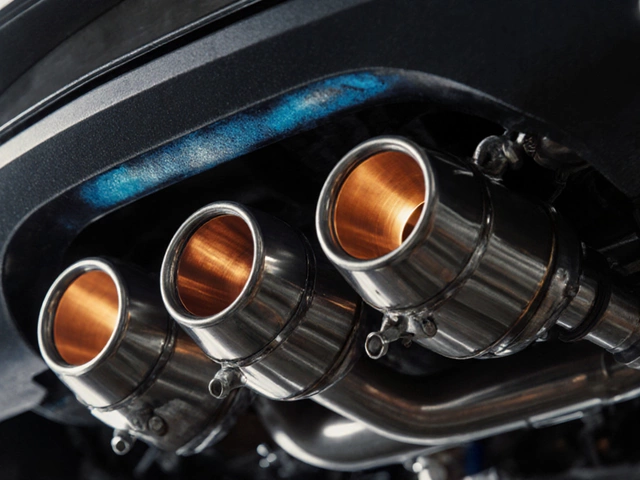Ever heard a car fly by, rumbling like thunder, and thought, “Man, that sounds incredible”? That’s no accident—it’s the exhaust working its magic. Swapping out your stock system for something better isn’t just about noise. It’s about personality, power, and—let’s not kid ourselves—a whole lot of attitude. But with countless options and a hundred brands in the game, you can blow serious cash and end up with something you regret. Performance, sound, compliance, and even looks—they’re all in play. Here’s everything you need to know before pulling the trigger on a new exhaust.
Why People Replace Exhausts: What’s the Real Story?
So why do people even bother swapping their exhaust? It’s not all about pure horsepower or making your Civic sound like an F1 car. For some, it’s about squeezing out extra horses—for others, it’s tuning the soundtrack perfectly. No two exhaust upgrades are the same, and your reasons to buy matter.
If you’re hunting for power, a less restrictive exhaust can improve how efficiently your engine breathes. That equals more torque, faster throttle response, and sometimes—though not always—better fuel economy. A full cat-back system can boost horsepower by 5% to 10%; axle-backs might be less, but they’ll change your note dramatically. According to Borla and MagnaFlow, you can see 8-12 extra horsepower on average. Doesn’t sound crazy, but you can feel it from the driver’s seat.
Some folks are all about personalization. The right exhaust lets you pick between deep, throaty V8 vibes or a snappy, high-pitched turbo chirp. Car clubs, meetups, or daily commutes—your exhaust is your signature. Let’s not forget aesthetics, either: polished tips peeking out from under the bumper are seriously satisfying.
And sometimes you don’t have a choice—rust, corrosion, or an accident means a new exhaust is non-negotiable. In that case, it’s a perfect excuse to upgrade. Better materials mean it’ll last longer and probably look cooler, too.
Before you shop, nail down your goals. Want every neighbor to know when you get home? Prioritize sound. Chasing that last shred of performance? Go big with headers and cat-backs. Want a no-fuss fix? Axle-back replacements are simple and budget-friendly.
Key Materials: Not All Exhausts Are Created Equal
Let’s talk about what your shiny new exhaust is actually made of. Material matters—a lot. Go cheap, and you’ll be back under the car next winter with a bottle of rust-remover. Spend a bit more, and you’ll forget what a replacement even is.
The common types are mild steel, aluminized steel, and stainless steel. Mild steel is cheap and does the job for a couple of years, but road salt will eat it alive. Aluminized steel is a step up—think budget performance lines—but still prone to rot if you drive in snow or wet climates.
Stainless steel exhausts are the gold standard. Grades matter: 409 stainless is solid, but 304 stainless is nearly immune to rust and corrosion. It’s what you want if you’re doing road trips or living anywhere there’s salt on the pavement. 304 costs more, sure, but there’s a reason the pros recommend it. Polished stainless also looks killer, and the burly sound is a nice plus.
Some boutique setups use titanium or even Inconel—especially on supercars. Titanium is stupid light and can shave about 30% of the weight, but it’s pricey. Not really practical for a daily, unless you’re swimming in cash.
Always check weld quality. Messy, splattery welds are a red flag—better craftsmanship means less chance of leaks or failures down the road. When in doubt, search for reviews or look at unboxing videos to see the actual parts.
| Material | Cost | Typical Lifespan | Best For |
|---|---|---|---|
| Mild Steel | Low | 1-3 years | Tight budgets, short-term fixes |
| Aluminized Steel | Medium | 3-6 years | Budget performance, dry climates |
| 409 Stainless | Mid-High | 8+ years | Daily drivers, longevity seekers |
| 304 Stainless | High | 15+ years | Premium upgrades, tough climates |
| Titanium | Very High | 15+ years | Track use, high-end builds |

Performance vs. Sound: What Really Matters to You?
Shopping for an exhaust is like picking a guitar amp—are you after pure volume, or that perfect, buttery tone? The big fight is always between performance and sound. Sometimes you get both, sometimes you have to choose your battles.
First up, let’s get real about sound. Cat-back systems swap everything from the catalytic converter to your tailpipes. They’re the sweet spot—solid growl, deeper tone, and not too much drone on the highway if you get a reputable brand. Axle-backs only touch the part behind the rear axle. They usually won’t change performance much, but they do tweak the audio. Muffler deletes send the decibel meter spinning, but you might hate the drone at 70 mph. Too loud? Your neighbors, your friends, and law enforcement might all start to hate your car.
For actual power, headers and downpipes are the name of the game. The more your engine can exhale, the happier (and gutsier) it gets. Turbo cars love a high-flow downpipe. Naturally aspirated V8s get wild gains from open-header setups. But here’s the deal: more power sometimes equals more noise—sometimes not the good kind. Cheap exhausts can sound tinny, raspy, or just plain annoying. Bad resonance can make your car sound like a wasp in a bottle at certain speeds.
Think about what bugs you more: volume or vibration? Brands like AWE, Corsa, and Akrapovic spend huge bucks tuning their systems for the right frequency. Read up or listen to sound clips before you buy. And if you daily your car, watch for “highway drone” in reviews.
If emissions and staying legal is a concern (and it probably is), make sure your setup is 50-state legal. Look for CARB certification in California and check your local rules if you don’t want hassle at inspection. Culprits like muffler deletes and straight pipes aren’t always street-legal, even if they sound epic.
Fitment: No One Likes a Headache Install
So you found the perfect exhaust online. It looks great, the price is almost suspiciously good, and you’re ready to buy. Not so fast—are you sure it actually fits? Fitment problems turn dream upgrades into six-hour agony sessions in your garage.
Direct-fit and “bolt-on” systems are what most people want. They’re designed specifically for your year, make, and model. No cutting, no welding, just wrenches and maybe a swear word or two. Universal systems are cheaper but often need extra brackets or hacking up your existing pipes. Unless you’ve got serious fabrication skills, stick to direct-fit.
Some brands (like MagnaFlow, Flowmaster, or Borla) have fit guides and online configurators that double-check compatibility before you click “add to cart.” Use them! And don’t trust eBay listings that claim “universal fit”—that can mean anything from “fits with work” to “bring your own welder.”
Consider whether you want a single or dual-exit system. Duals mean symmetry, but not every car is built for them. Some require swapping bumpers or cutting valances. Check your trunk clearance, especially if you haul stuff or have a spare tire under there.
Before the install, research what comes in the box. Gaskets, hangers, and clamps aren’t always included. Double-check before you start so you don’t end up making a last-minute run to the hardware store.
If you’re worried about warranty, don’t touch your catalytic converters or emissions equipment unless you’re 100% sure you’re covered by the brand (or happy to risk it). Keep your old exhaust, just in case—you might need it to pass inspection or sell the car later.

Brands, Budget, and What the Pros Recommend
This is where things get real. With car exhausts, you really do get what you pay for, but that doesn’t mean you need to empty your bank account. Names like Borla, MagnaFlow, Corsa, Flowmaster, Akrapovic, and AWE always show up in enthusiast forums—and for good reason. Their systems are purpose-built, sound-tested, and usually come with long warranties (sometimes a million miles with Borla—crazy, right?).
Cheap off-brand options can be tempting, especially with online retailers popping up everywhere. But beware: inconsistent fit, bad welds, and mystery metals mean you might be ordering the same part next year. Stick with names you recognize if you want to avoid headaches.
Many quality exhausts run $700-$2,000 for cat-backs, less for axle-backs, and much more for titanium or custom jobs. If you see something much cheaper, ask yourself why. Some brands have fake knockoffs—if it seems too good to be true, dig deeper or look for verified dealers.
Pro tip: read or watch real-world reviews, especially with your car or engine combo. Facebook groups and forums are goldmines for honest experiences. Some brands get louder over time as coiled fibers inside the muffler burn off—a detail they usually don’t put on the box. If you want something stealthy, ask what it sounds like after 10,000 miles.
Finally, consider resale value. Some upgrades can increase your car’s curb appeal and make selling easier. But wild, ear-busting systems might limit your pool of buyers down the road.
- Stick with reputable brands for warranty and support
- Check for sound clips with your specific car—what sounds amazing on a Mustang might be annoying on a Honda
- Keep old parts if you want an easy return to stock when selling
- Get professional help if you’re not confident in your tools or lift setup
When it’s time to buy an exhaust, you want something that nails the vibe, works with your car, lasts for years, and puts a little spark in every drive. Good luck out there, and don’t forget to roll those windows down and enjoy the music your car makes.


